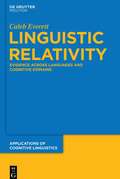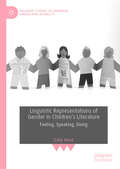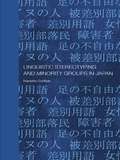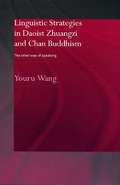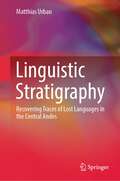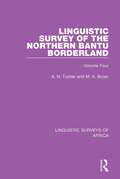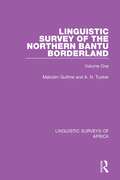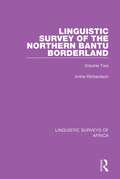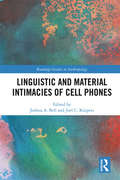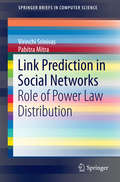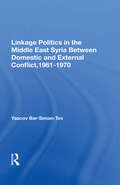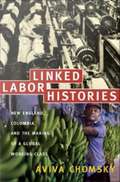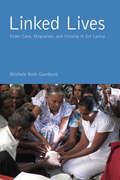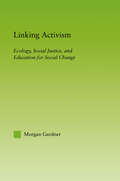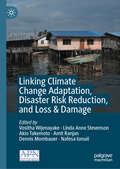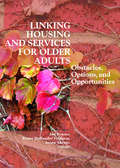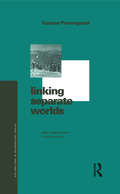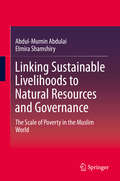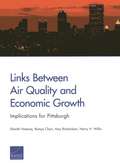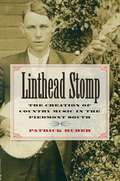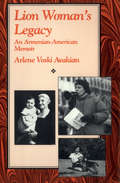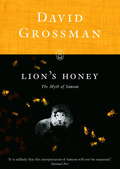- Table View
- List View
Linguistic Relativity: Evidence Across Languages and Cognitive Domains (Applications of Cognitive Linguistics Ser. #25)
by Caleb EverettThis book introduces the reader to the current findings on linguistic relativity, and in so doing helps to answer one of the most vexing questions in the cognitive and social sciences: Does the language you speak affect how you think?
Linguistic Representations of Gender in Children's Literature: Feeling, Speaking, Doing (Palgrave Studies in Language, Gender and Sexuality)
by Sally HuntThis book examines how aspects of gender and identity are represented in some of the best-selling children's book series published in English over the last 100 years. Combining the quantitative methods of corpus linguistics with Critical Discourse Analytic interpretation, the author's analysis shows how gendered constructions of identity are built on uneven patterns of representation. Stories, and the characters who inhabit them, not only provide child readers with entertainment, but also the building blocks of their identities: linguistic choices construct representations of how to be a girl or how to be a boy, often in binary, mutually exclusive terms. Hunt's critical corpus linguistic approach uncovers patterns of representation beyond the fiction author's awareness, which reveal their assumptions about how girls and women behave, or should behave, or what boys and men do, or should do. Chapters cover the gendered patterns found in how characters speak, how they express emotion and how they act on the world, as well as those characters who contradict these patterns and perform their genders in different ways. The detailed analysis and its implications will be relevant to teachers of literature, both at school and at university level, media researchers, lecturers and students of linguistics or gender studies, and anyone interested in child development and the fiction written for children.
Linguistic Response to the Taboo of Death in Egyptian Arabic
by Magdalena ZawrotnaThe work presents a study of the linguistic and pragmatic response to the taboo of death in Egypt. The analysis leads the author to the conclusion that the experience of death in Egyptian society is mediated by religion. The reaction to death announcements includes a number of strategies to protect both the author of the utterance and its recipient against the effects of the taboo related to this topic. The most important feature of the studied communication is formulaicity, which is at the same time the central idea and the methodological frame of the work presented here.The discourse analyzed here fits within the Arab-Muslim rhetorical framework. In the daily utterances of the Egyptians, divine agency is believed to be constantly present, which is attested in numerous ritual practices. As part of the quantitative study and the structural analysis of the material, a pattern was distinguished in which individual types of formulas occur in their fixed places and a specific order. Qualitatively, many of the statements in the material are strongly emotional. To enhance the pragmatic effect, phrases are combined with each other, repetitions, prayers, poetic attempts and quotes from the Quran/ Hadith appear. Most of the phrases used in response to the taboo of death are prefabricated items recalled from memory almost automatically. Further analysis proposes to look at the formulae in the context of taboo and strong emotions related to it. Using formulaic sequence instead of generating novel language enables. the author of the utterance to convey emotional support to the suffering person and, at the same time, eliminates ambiguity. The methodology proposed here offers a new insight into the language of everyday communication, through the lens of its pragmatic usefulness and linguistic etiquette, taking into account the cultural framework in which the analyzed utterances are performed.
Linguistic Stereotyping and Minority Groups in Japan (Routledge Contemporary Japan Series)
by Nanette GottliebThis book is the first full-length study in English to examine the use of discriminatory language in Japan. As in other countries, there has been much debate about the public use of language deemed demeaning to certain groups within society especially in relation to the issue of minority rights versus freedom of speech. Adding a new dimension to the discussion of language and society in Japan, the book focuses on an aspect of language and power which highlights some of the dissent underlying Japan’s officially promoted ideology of a harmonious society. The text presents a revealing examination of the discriminatory language, known as sabetsu yogo, as identified by five minority groups, the Burakumin, the Ainu, people with physical or mental disabilities, women and ethnic groups within Japan
Linguistic Strategies in Daoist Zhuangzi and Chan Buddhism: The Other Way of Speaking
by Youru WangAs the first systematic attempt to probe the linguistic strategies of Daoist Zhuangzi and Chan Buddhism, this book investigates three areas: deconstructive strategy, liminology of language, and indirect communication. It bases these investigations on the critical examination of original texts, placing them strictly within soteriological contexts. Whilst focusing on language use, the study also reveals some important truths about these two traditions and challenges many conventional understandings of them. Responding to recent critiques of Daoist and Chan Buddhist thought, it brings these two traditions into a constructive dialogue with contemporary philosophical reflection. It discovers Zhuangzian and Chan perspectives and sheds light on issues such as the relationship between philosophy and non-philosophy, de-reification of words, relativising the limit of language, structure of indirect communication, and use of paradox, tautology and poetic language.
Linguistic Stratigraphy: Recovering Traces of Lost Languages in the Central Andes
by Matthias UrbanThis book examines the historical linguistic panorama of Western South America, focusing on the minor languages that were partially or fully replaced by the expansion of the Quechuan family through the region.The author presents a coherent and generally applicable framework for studying prehistoric language shift processes and reconstructing earlier linguistic landscapes before significant language spreads ousted former patterns of linguistic diversity. This framework combines toponymic evidence with the analysis of substrate contact effects, and, in some cases, extralinguistic evidence, to create an integrated if incomplete of extinct and undocumented languages. In an authoritative exploration of case studies, concerning Aymara in parts of Southern Peru, Cañar in Ecuador, and Chacha in Northern Peru, the book shows how the identities of lost languages and earlier linguistic panoramas can be reconstructed.
Linguistic Survey of the Northern Bantu Borderland: Volume Four (Linguistic Surveys of Africa #9)
by M. A. Bryan A. N. TuckerThe classification and distribution of the languages of the Northern Bantu Borderland between the Great Lakes and the Indian Ocean have been given in Volume 1 of The Linguistic Survey of the Northern Bantu Borderland, where however, the linguistic evidence on which the classification rested was not included. This is now set out in this volume, originally published in 1957. The languages have been divided into three categories: Bantu, partly Bantu and non-Bantu. within each category the languages have been grouped according to linguistic criteria. The choice of languages represented here has been determined by the availability of reliable linguistic material.
Linguistic Survey of the Northern Bantu Borderland: Volume One (Linguistic Surveys of Africa #7)
by A. N. Tucker Malcolm GuthrieThe northern limit of the Bantu languages is one of the important linguistic boundaries of Africa and this and the subsequent 3 volumes provide an invaluable resource which delimits the frontier. Since a number of the languages investigated had not hitherto been recorded, while with others the published information was inadquate and confused the Linguistic Survey of the Northern Bantu Borderland can justifiably be described as a pioneering study. This volume consists of demographic information together with maps and tabulated indications of the affinities of the languages.
Linguistic Survey of the Northern Bantu Borderland: Volume Two (Linguistic Surveys of Africa #8)
by Irvine RichardsonThis volume, originally published in 1957, contains the linguistic evidence for the classification of the languages encountered by the western team of the Northern Bantu Borderland Survey. To appreciate fully its implications it should be read in close conjunction with the appropriate sections of Volume 1 of the Survey, dealing with the demography of this area. The inclusion of some languages over others in this volume in no way reflects its demographic or linguistic importance, but simply indicates that the evidence was available to the Survey. The material is original and except where otherwise indicated was taken down by the team in phonetic script from local informants in situ.
Linguistic Tactics and Strategies of Marginalization in Japanese
by Judit Kroo Kyoko SatohThis edited book brings together studies on different aspects of marginalization in Japanese, creating a framework for studying marginalization which can also be applied in other linguistic and international contexts. The chapters in this book look at both marginalization of others and self-marginalization, examining the pragmatic strategies used to achieve marginalization, and investigating situations where it acts as an agentive tactic of speakers, in addition to a strategy of broader social structures. This book will be of interest to students and scholars of sociolinguistics, pragmatics, linguistic anthropology, and East Asian languages and cultures.
Linguistic and Material Intimacies of Cell Phones
by Joshua A. Bell Joel C. KuipersLinguistic and Material Intimacies of Cell Phones offers a detailed ethnographic and anthropological examination of the social, cultural, linguistic and material aspects of cell phones. With contributions from an international range of established and emerging scholars, this is a truly global collection with rural and urban examples from communities across the Global North and South. Linking the use of cell phones to contemporary discussions about representation, mediation and subjectivity, the book investigates how this increasingly ubiquitous technology challenges the boundaries of privacy and selfhood, raising new questions about how we communicate.
Link Prediction in Social Networks
by Virinchi Srinivas Pabitra MitraThiswork presents link prediction similarity measures for social networks that exploitthe degree distribution of the networks. In the context of link prediction indense networks, the text proposes similarity measures based on Markov inequalitydegree thresholding (MIDTs), which only consider nodes whose degree is above a thresholdfor a possible link. Also presented are similarity measures based on cliques(CNC, AAC, RAC), which assign extra weight between nodes sharing a greater numberof cliques. Additionally, a locally adaptive (LA) similarity measure isproposed that assigns different weights to common nodes based on the degreedistribution of the local neighborhood and the degree distribution of thenetwork. In the context of link prediction in dense networks, the textintroduces a novel two-phase framework that adds edges to the sparse graph toforma boost graph.
Linkage Politics In The Middle East: Syria Between Domestic And External Conflict, 1961-1970
by Yaacov Bar-siman-tovTraditional studies of linkage politics tend to assume that internal political instability leads a government to divert attention from internal problems by initiating an external conflict or stressing the pressures of international problems. In contrast, quantitative studies typically conclude that there is little or no relationship between interna
Linked Labour Histories: New England, Colombia, and the Making of a Global Working Class
by Aviva ChomskyExploring globalization from a labor history perspective, Aviva Chomsky provides historically grounded analyses of migration, labor-management collaboration, and the mobility of capital. She illuminates the dynamics of these movements through case studies set mostly in New England and Colombia. Taken together, the case studies offer an intricate portrait of two regions, their industries and workers, and the myriad links between them over the long twentieth century, as well as a new way to conceptualize globalization as a long-term process. Chomsky examines labor and management at two early-twentieth-century Massachusetts factories: one that transformed the global textile industry by exporting looms around the world, and another that was the site of a model program of labor-management collaboration in the 1920s. She follows the path of the textile industry from New England, first to the U. S. South, and then to Puerto Rico, Japan, Mexico, Central America, the Caribbean, and Colombia. She considers how towns in Rhode Island and Massachusetts began to import Colombian workers as they struggled to keep their remaining textile factories going. Most of the workers eventually landed in service jobs: cleaning houses, caring for elders, washing dishes. Focusing on Colombia between the 1960s and the present, Chomsky looks at the Urab banana export region, where violence against organized labor has been particularly acute, and, through a discussion of the AFL-CIO's activities in Colombia, she explores the thorny question of U. S. union involvement in foreign policy. In the 1980s, two U. S. coal mining companies began to shift their operations to Colombia, where they opened two of the largest open-pit coal mines in the world. Chomsky assesses how different groups, especially labor unions in both countries, were affected. Linked Labor Histories suggests that economic integration among regions often exacerbates regional inequalities rather than ameliorating them.
Linked Lives: Elder Care, Migration, and Kinship in Sri Lanka (Global Perspectives on Aging)
by Michele Ruth GamburdWhen youth shake off their rural roots and middle-aged people migrate for economic opportunities, what happens to the grandparents left at home? Linked Lives provides readers with intimate glimpses into homes in a Sri Lankan Buddhist village, where elders wisely use their moral authority and their control over valuable property to assure that they receive both physical and spiritual care when they need it. The care work that grandparents do for grandchildren allows labor migration and contributes to the overall well-being of the extended family. The book considers the efforts migrant workers make to build and buy houses and the ways those rooms and walls constrain social activities. It outlines the strategies elders employ to age in place, and the alternatives they face in local old folks’ homes. Based on ethnographic work done over a decade, Michele Gamburd shows how elders face the challenges of a rapidly globalizing world.
Linking Activism: Ecology, Social Justice, and Education for Social Change (New Approaches in Sociology)
by Morgan GardnerThis book, a unique examination of the activist striving to work for more holistic social change, creates a conceptual framework to give visibility to the complexity of activist practice that spans environmental and social justice concerns.
Linking Climate Change Adaptation, Disaster Risk Reduction, and Loss & Damage
by Linda Anne Stevenson Amit Ranjan Dennis Mombauer Vositha Wijenayake Akio Takemoto Nafesa IsmailThis book advances knowledge on loss & damage (L&D) and its interlinkages with climate adaptation and disaster risk reduction. The book includes twelve case studies conducted across South and Southeast Asia, covering sectors including agriculture, rural livelihoods, energy, infrastructure and natural resources. These studies provide insights into complex climate-induced L&D, enhancing local, national and regional knowledge and contributing to global agendas.
Linking Housing and Services for Older Adults: Obstacles, Options, and Opportunities
by Jon Pynoos Penny Hollander Feldman Joann AhrensPackaging supportive services with housing-a pressing issue for older adultsThe population of older adults is expected to explode in the coming years. Linking Housing and Services for Older Adults: Obstacles, Options, and Opportunities examines a crucial, complex, and often overlooked issue for policymakers and the public at large: older adults&’ increasing needs for housing and supportive long-term care services. As baby boomers strive to help their parents make difficult decisions about their options, pressure mounts for policymakers to develop appropriate housing and services. This book brings together respected experts to discuss the answers to difficult questions about meeting the housing and support service needs of aging adults.Linking Housing and Services for Older Adults: Obstacles, Options, and Opportunities explores in-depth the tough issues pertaining to which populations are presently being served, what their needs are, and who is being left out. You&’ll learn exactly what types of services are available, who is providing them, and how are they packaged. From residential care to assisted living to institutional care, this book addresses all facets of the complicated problems of providing availability to fulfill need. This important source presents insightful analysis of the total range of issues and the challenges to progress as well as offering specific recommendations to effectively offer housing and vital long-term care supportive services to older adults.Linking Housing and Services for Older Adults: Obstacles, Options, and Opportunities discusses in detail: the argument for increased development of supportive housing for older adults-and the barriers preventing it the issues related to providing a variety of housing and service options to the Medicaid population two case studies that illustrate how policies aimed at linking housing and services play out at the state and local level-and the need for strong leadership and the ability to develop key partnerships as vital aspects for success the interrelationship of factors regarding nursing home admission, the availability of subsidized housing, and Medicaid eligibility the need for care management to be holistic-including environmental care assessment, repair, and renovation management in addition to current long-term care settings creating affordable assisted living facilities for older persons receiving Medicaid services the successful components of the national Coming Home Program four case studies emphasizing different finance and regulatory approaches-providing lessons learned for developers, state agencies, and advocates of affordable assisted livingThis vital educational resource is also an essential reference for local, state, and national policymakers, housing officials, and long-term care providers.
Linking Separate Worlds: Urban Migrants and Rural Lives in Peru (Explorations in Anthropology)
by Karsten PaerregaardThis pathbreaking ethnography of population movements between rural and urban places in Peru addresses the conceptual and methodological problems of studying ‘deterritorialized' populations and the implications of this for anthropology's notions of culture and identity. Based on extensive fieldwork, this book explores the economic, social and ritual bonds which link migrants in Peru's major cities to their Andean native village. Many urban migrants establish networks based on kinship and marriage ties to exploit resources in the city as well as the village. These networks ensure they maintain strong links to their native village. Fiestas, soccer tournaments and folklore festivals also play a crucial role in the formation of migrant communities in Peru's cities. The author analyses these performance practices and shows how they give rise to the creation of new social identities. The participation of second generation migrants, returning migrants, and migrant spouses in village life is also discussed.
Linking Sustainability to Competitiveness
by Luca Salvati Alessandro MuoloThis book identifies and discusses opportunities and constraints in applying the sustainability paradigm to urbanization. It integrates this wide concept with ‘local competitiveness’ and focuses on the role of both general and specific political action in shaping the economic structure of a region.By linking sustainability and local competitiveness within metropolitan regions, it offers an innovative exploration of urbanization processes. Moving beyond the usual institutional and regional economic approaches, the book integrates perspectives from economic geography, sociology, demography, ecology, and planning. It presents practical tools and real-world data, enabling readers to interpret and delve into new urban development paths. By exploring the interaction between urban sustainability and economic competitiveness, a framework is provided that supports informed policymaking decisions at local, regional, and national scales.This book is written for academics and students—from undergraduates to doctoral candidates—who want a clear, practical look at how local economies, sustainability, and competitiveness come together. It is also helpful for professionals, policymakers, and for anyone curious about how economic growth might become a long-term sustainable political goal.
Linking Sustainable Livelihoods to Natural Resources and Governance
by Abdul-Mumin Abdulai Elmira ShamshiryThis book investigates the current level and trend of poverty in the Muslim World, including selected countries in Africa, the Middle East and Central Asia, East Asia, the Pacific and South America. Authors explore themes of poverty reduction, poverty alleviation and the extent of influences on social and economic development, particularly natural resource endowments (especially mineral resources) and their utilization. Chapters explore theory and practice, including governance and programmes, and take a detailed look at Zakat as a faith-based policy tool, to reduce poverty and improve livelihoods and thus contribute to better environmental stewardship. The final chapters look at development questions in the Muslim World and make policy recommendations, including a proposed multi-dimensional development collaboration model called the Development Collaboration Octagon Model (DeCOM). Readers will discover theoretical explanations of poverty and how poverty hampers the development of many nations because the poor are unable to partake actively in the development process. Poverty indicators and measurement are discussed, and trends of economic growth including productivity, manufacturing, trade patterns, investment and saving activity, and socio-economic developments are all explored: supporting data is presented in tables and figures, throughout this text. Authors explore the potency and success stories of public poverty alleviation strategies and programmes pursued in the Muslim world, especially the extent to which the institution of Zakat has been effectively incorporated into public poverty alleviation strategies. Policy options required to enhance social and economic development are proposed, to help pull the poor out of the poverty trap into the mainstream economy in the Muslim world. This work will appeal to anyone wishing to scrutinise poverty, its parameters and its relationship with the development of countries in the Muslim world. Scholars in the fields of economics, sociology, geography and Islamic studies will all find something of value here.
Links Between Air Quality and Economic Growth: Implications for Pittsburgh
by Henry H. Willis Amy Richardson Shanthi Nataraj Ramya ChariThis report assesses the evidence that exists for the ways in which local air quality could influence local economic growth through health and workforce issues, quality-of-life issues, or air-quality regulations and business operations. It then extrapolates some of the existing results to the Pittsburgh region.
Linthead Stomp
by Patrick HuberContrary to popular belief, the roots of American country music do not lie solely on southern farms or in mountain hollows. Rather, much of this music recorded before World War II emerged from the bustling cities and towns of the Piedmont South. No group contributed more to the commercialization of early country music than southern factory workers. In Linthead Stomp, Patrick Huber explores the origins and development of this music in the Piedmont's mill villages. Huber offers vivid portraits of a colorful cast of Piedmont millhand musicians, including Fiddlin' John Carson, Charlie Poole, Dave McCarn, and the Dixon Brothers, and considers the impact that urban living, industrial work, and mass culture had on their lives and music. Drawing on a broad range of sources, including rare 78-rpm recordings and unpublished interviews, Huber reveals how the country music recorded between 1922 and 1942 was just as modern as the jazz music of the same era. Linthead Stomp celebrates the Piedmont millhand fiddlers, guitarists, and banjo pickers who combined the collective memories of the rural countryside with the upheavals of urban-industrial life to create a distinctive American music that spoke to the changing realities of the twentieth-century South.
Lion Woman's Legacy: An Armenian-American Memoir (The\cross-cultural Memoir Ser.)
by Arlene Voski AvakianA &“vivid and engrossing&” narrative of one woman&’s journey from shame and internal conflict to becoming a liberated, confident, and proud lesbian (Kirkus Reviews). The descendant of survivors of the Armenian genocide, Arlene Avakian was raised in America where she could live free. But even with that freedom, she found herself a prisoner of both her family and society, denying her heritage along with her true sexuality. After marriage and motherhood, Arlene found herself exploring the growing women&’s lib movement of the 1970s, coming to embrace the strength of her grandmother—known as the Lion Woman—and realizing her full potential and personhood. Inspired by her passionate feminism and strengthened by a loving lesbian relationship, Avakian recollects and re-examines her personal history and the story of her courageous grandmother, revealing a legacy of radical politics, fierce independence, and a powerful affirmation of ethnic identity in this &“extremely readable and often painfully honest book&” (Library Journal).
Lion's Honey
by David GrossmanA consideration of one of the Bible's most powerful stories from a leading Israeli writer In this fascinating reexamination of the story of Samson, David Grossman goes beyond the surface of the familiar tale to look into what the life of this extraordinary man must have been like. What it felt like to have been "chosen" to release his people from the yoke of the Philistines, and yet alienated from them by his very otherness; what moved him to his acts of wild vandalism and his self-destructive passions; why he chose to keep some things secret, but not the most significant secret of all. We are left with the troubling knowledge that Samson bore too heavy a burden even for a man of his supernatural strength to bear alone."There are few other Bible stories with so much drama and action, narrative fireworks and raw emotion, as we find in the tale of Samson: the battle with the lion; the three hundred burning foxes; the women he bedded and the one woman that he loved; his betrayal by all the women in his life, from his mother to Delilah; and, in the end, his murderous suicide, when he brought the house down on himself and three thousand Philistines. Yet beyond the wild impulsiveness, the chaos, the din, we can make out a life story that is, at bottom, the tortured journey of a single, lonely and turbulent soul who never found, anywhere, a true home in the world, whose very body was a harsh place of exile. For me, this discovery, this recognition, is the point at which the myth - for all its grand images, its larger-than-life adventures - slips silently into the day-to-day existence of each of us, into our most private moments, our buried secrets."-from David Grossman's introduction to Lion's HoneyFrom the Hardcover edition.
